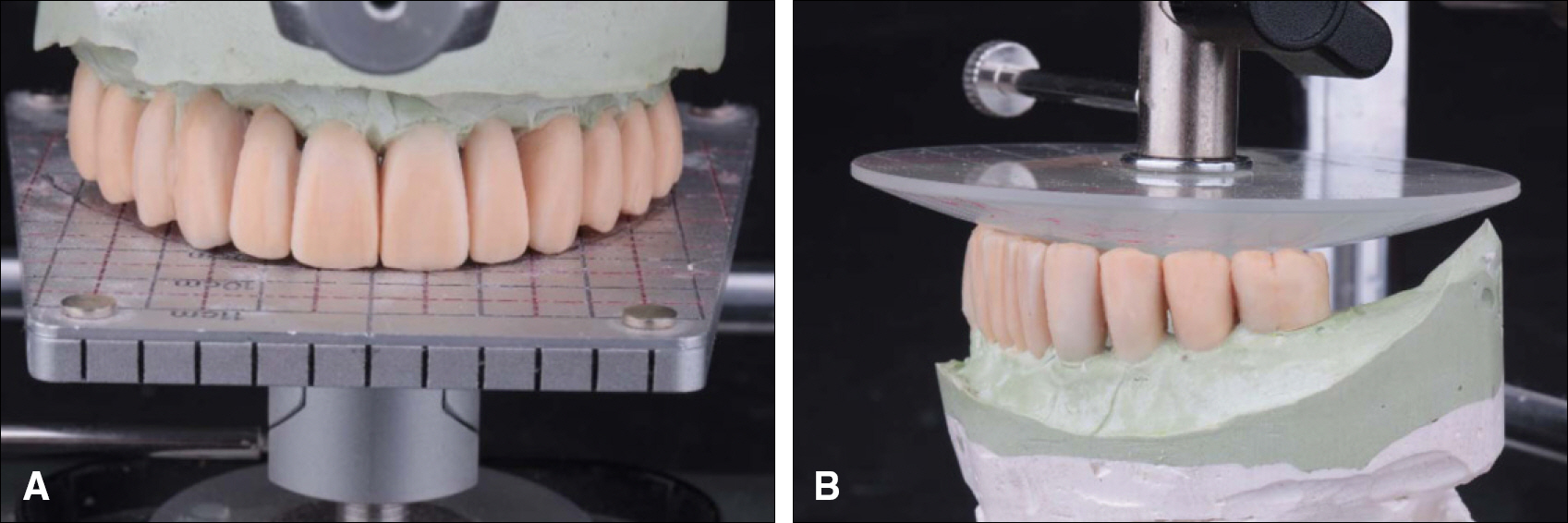Full mouth implant rehabilitation with double scanning of provisional restoration
- Affiliations
-
- 1Department of Prosthodontics, School of Dentistry, Chonnam National University, Gwangju, Republic of Korea. msvang@chonnam.ac.kr
- KMID: 2195440
- DOI: http://doi.org/10.4047/jkap.2014.52.3.252
Abstract
- It is important to produce a provisional restoration reflecting the patient's jaw relation, occlusal plane, lip support, shape of teeth, and occlusion type for fully edentulous patients before making a definite prosthesis. The patient introduced in this study showed bad prognosis of remained tooth after severe periodontal diseases. Therefore, remaining teeth were extracted and replaced with dental implants. Provisional restorations were fabricated and the the patient's vertical and horizontal jaw relationship, occlusal plane, amount of overjet and overbite, size of teeth, and length of anterior tooth were recorded. Provisional restorations were scanned and CAD/CAM techniques were used to fabricate a monolithic zirconia bridge, which contour is identical with the provisional restorations. The patient was satisfied with the treatment results on functional, esthetic aspects and the prosthesis retained stable during the four-month clinical observation period.
MeSH Terms
Figure
Cited by 3 articles
-
Full mouth rehabilitation of the patient with crossed occlusion using implant fixed prosthesis: A case report
Byung-Suk Jung, Young-Chan Jeon, Chang-Mo Jeong, Mi-Jung Yun, So-Hyoun Lee, Jung-Bo Huh
J Korean Acad Prosthodont. 2018;56(4):338-346. doi: 10.4047/jkap.2018.56.4.338.Rehabilitation in a patient with limited restorable space using double scanning technique: A case report
Jun-Yub Kim, Sang-Won Park, Hyun-Pil Lim, Kwi-Dug Yun, Hongso Yang
J Korean Acad Prosthodont. 2017;55(2):205-211. doi: 10.4047/jkap.2017.55.2.205.Aesthetic restoration n patients with unaesthetic maxillary anterior teeth using double scan : A case report
Chang Woo Ko, Min-Ji Kim, Hong-So Yang, Sang-Won Park, Chan Park, Kwi-Dug Yun
J Korean Acad Prosthodont. 2018;56(2):166-172. doi: 10.4047/jkap.2018.56.2.166.
Reference
-
1. Cho Y, Raigrodski AJ. The rehabilitation of an edentulous mandible with a CAD/CAM zirconia framework and heat-pressed lithium disilicate ceramic crowns: a clinical report. J Prosthet Dent. 2014; 111:443–7.
Article2. Karl M, Graef F, Wichmann M, Krafft T. Passivity of fit of CAD/CAM and copy-milled frameworks, veneered frameworks, and anatomically contoured, zirconia ceramic, implant-supported fixed prostheses. J Prosthet Dent. 2012; 107:232–8.
Article3. Misch CE. Contemporary Implant Dentistry. 3rd ed.St. Louis: CV Mosby;2009. p. 367–88.4. Rakosi T. Cephalometric Radiography: Significance of Angular and Linear Measurements for Dento-skeletal Analysis. Kuk Jae D.M Publishing Co.;1994. p. 46–77.5. Kim JC, Jung CW. OP Finder System & Zirconia Prosthesis: Occlusal Plane Finder 2 & Opus 1 Articulator. 2010 DaehanNarae Publishing Inc.;2010. p. 45–9.6. The council of the faculty of otrhodontics. Textbook of Orthodontics. 2nd ed.DaehanNarae Publishing Inc.;2006. p. 177–87.
- Full Text Links
- Actions
-
Cited
- CITED
-
- Close
- Share
- Similar articles
-
- Digital duplication of provisional prosthesis to fabricate definitive prosthesis for full mouth rehabilitation using double scan technique
- Full mouth rehabilitation with vertical increase in patient with severe tooth wear using monolithic zirconia prosthetic restoration
- Full mouth rehabilitation of a severely worn dentition using intraoral scanner and the CAD/CAM double scanning technique
- Full mouth rehabilitation of edentulous patient with fixed implant prosthesis
- Computer-aided design and manufacturing-based full mouth rehabilitation for a patient with excessive attrition and restricted vertical dimension: A case report










